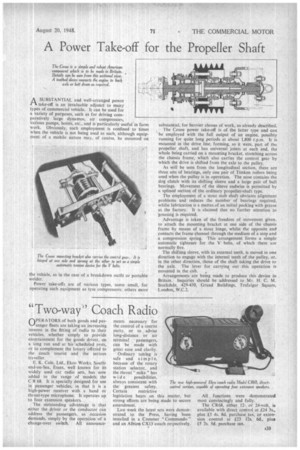A Power Take-off for the Propeller Shaft
Page 53

If you've noticed an error in this article please click here to report it so we can fix it.
ASUBSTANTIAL and well-arranged power take-off is an invaluable adjunct to many types of commercial vehicle. It can be used for a variety of purposes, such as for driving comparatively large dynamos, air compressors,
various pumps, hoists, etc., and is particularly useful in farm work. Obviously, such employment is confined to times when the vehicle is not being used as such, although equipment of a mobile nature may, of course, be mounted on . the vehicle, as in the case of a breakdown outfit or portable welder.
Power take-offs are of various types, some small, for operating such equipment as tyre compressors; others more substantial, for heavier classes of work, as already described.
The Couse power take-off is of the latter type and can be employed with the full output of an engine, possibly running for quite long periods at about 1,800 r.p.m. It is mounted in the drive line, forming, as it were, part of the propeller shaft, and has universal joints at each end, the whole being carried on a mounting bracket, stretching across the chassis frame, which also carries the control gear by which the drive is shifted from the axle to the pulley.
As will be seen from the longitudinal section, there are three sets of bearings, only one pair of Timken rollers being used when the pulley is in operation. The nose contains the dog clutch with its shifting sleeve and a large pair of ball bearings. Movement of the sleeve endwise is permitted by a splined section of the ordinary propeller-shaft type.
The employment of a stout stub shaft obviates alignment problems and reduces the number of bearings required, whilst lubrication is a matter. of an initial packing with grease at the factory. It is claimed that no further attention to greasing is required.
Advantage is taken of the freedom of movement given, to attach the mounting bracket at one side of the chassis frame by means of a stout hinge, whilst the opposite end contacts the frame channel through the medium of a stop and a compression spring. This arrangement forms a simple automatic tightener for the V belts, of which there are normally five.
The shifting sleeve, with its external teeth, is moved in one direction to engage with the internal teeth of the pulley, or, in the other direction, those of the shaft taking the drive to the axle. The lever for carrying out this operation is mounted in the cab.
Arrangements are being made to produce this device in Britain. Inquiries should be addressed to Mr. H. C. M. Stockdale. 429-430, Grand Buildings, Trafalgar Square, London, W.C.2.






















































































